Ranking the Sean Connery James Bond Movies
The first and arguably best James Bond actor created our idea of 007, but which Sean Connery installment is the greatest?
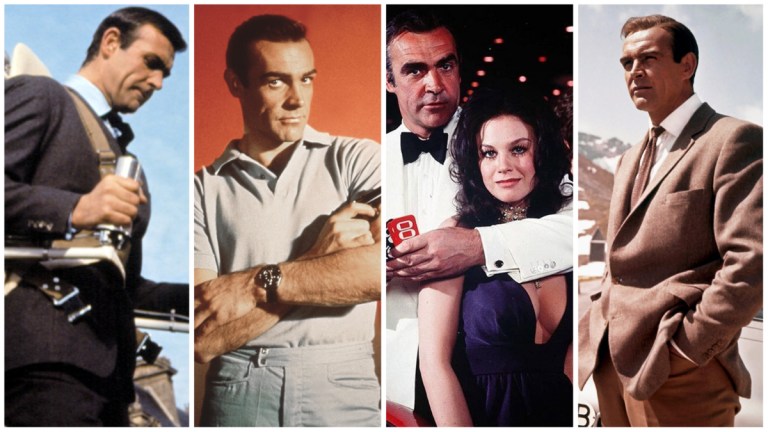
Sixty years is a long time in the lifespan of a human being. And in the life cycle of a fictional character’s popularity, it’s usually unthinkable: a vast ocean of time which is rarely crossed by products of something as fleeting and fickle as pop culture. Nevertheless, six decades since Sean Connery first donned the tuxedo and uttered the iconic line of “Bond, James Bond,” the 007 character has endured in popularity.
In fact, during the character’s golden jubilee in 2012, Bond became arguably bigger than ever with the 50th anniversary also coinciding with the highest grossing Bond film at the box office, courtesy of Skyfall… of course that record only holds if you don’t count inflation, or certainly the amount of tickets sold by Connery’s fourth outing as MI6’s best man, Thunderball (1965). Either way, even the dour and brooding Craig movies still act as a reflection, and perhaps deflection, of the image Connery built by playing James Bond for five films in the 1960s, and then coming out of 007 retirement twice in subsequent decades.
The original actor to play the cinematic version of Ian Fleming’s creation, Connery is still generally hailed as the best Bond from fans of multiple generations. Even so, not all Sean Connery Bond movies were created equal. And for that reason, we’ve hunkered down and decided to rank Connery’s Bond films from worst to best. Enjoy.
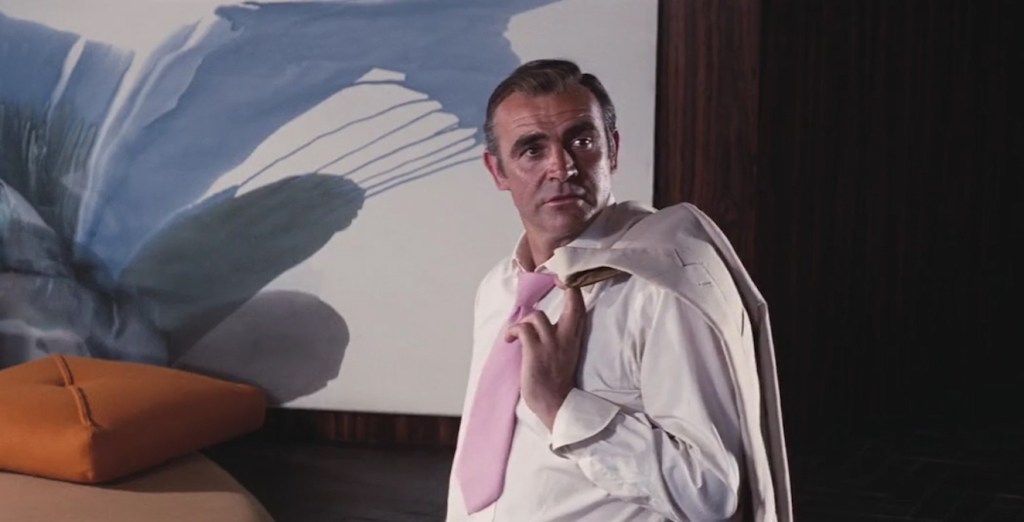
7. Diamonds Are Forever (1971)
We can admit Diamonds Are Forever is a victim of juxtaposition. As the direct follow-up to On Her Majesty’s Secret Service (1969), which was the first Bond movie not to star Sean Connery as 007, DAF was tasked with continuing another version of the character’s story. For when we left George Lazenby’s Bond, he was crying over the body of his bride, Teresa di Vicenzo (Diana Rigg), on their wedding day. Rigg’s Tracy was one of the best leading ladies the series ever knew, and her death was a blow to Bond and, particularly in posterity, the fans who discovered OHMSS as a forgotten classic on home video.
In 1969, however, it was a box office disappointment. Audiences weren’t ready to see anyone playing Bond except Connery, and while it’s an interesting idea to imagine Connery playing the more vulnerable 007 depicted by Lazenby, his return in DAF was a haphazard attempt at franchise course correction. Connery was back; Goldfinger director Guy Hamilton returned while cranking the camp element to 11; and even Shirley Bassey sang the opening theme song again. Yet it all falls flat, particularly to modern audiences who cannot help but be disappointed by Bond only vaguely alluding to the fact that Blofeld murdered his wife. It doesn’t help the villain is also recast for the umpteenth time, here in his worst incarnation thanks to a misjudged performance by Charles Gray. It’s likewise hard to take Bond’s rage seriously when he’s smirking throughout his three-minute “revenge” opening sequence.
Don’t worry, Blofeld isn’t killed off during a pre-titles sequence… at least this time. However, the fiend is left hanging from a crane in a limp visual gag at the end of the movie. That DAF has no idea how to resolve its villain’s fate acts as a metaphor for this shambolic mess as a whole. Connery is slightly less bored than in You Only Live Twice, but at this point he is treating Bond as a cartoon character. And given all the self-parody around him, complete with homophobic henchmen Mr. Kidd and Mr. Wint (Putter Smith and Bruce Glover as embodiments of gay panic), one cannot really blame Connery for treating this like a B-effort. Compared to the rest of the film, that’s grading on a curve.
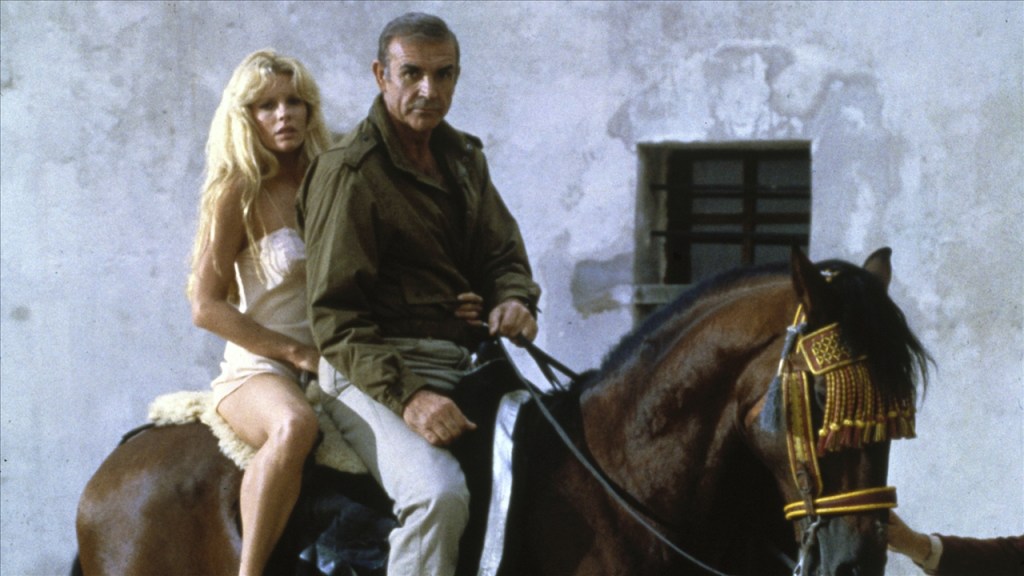
6. Never Say Never Again (1983)
Normally, we at Den of Geek fall more on the side of Eon Productions purists when it comes to evaluating the Bond canon—which is to say we normally exclude 007 copycat films created in the shadow of Eon Productions’ franchise by a quirk of copyright fates: your Casino Royales of ’67 and your Never Say Never Agains. However, if one is going to gauge the full legacy of Connery’s contributions to the James Bond character, then it would be close to negligent to ignore this red-headed stepchild of the Bond franchise.
A remake of Thunderball in all but title, Never Say Never Again exists because of the litigious belligerence of producer Kevin McClory—as well as arguably because of the undying love many audiences have for Connery in the Bond role. Indeed, the main reason McClory got this far in producing a successful redo of Thunderball (a feat he never achieved again despite multiple attempts) is because Connery agreed to take a hefty paycheck more than a decade after hanging up the tux for a second time. And despite its cynical origins, we have to concede it is not the worst Connery Bond film, albeit that has more to say about Diamonds Are Forever than it does Never Say Never Again.
This ’83 picture is a shaggy and rather listless retread of a story that was never Fleming’s greatest work the first-time round. Add-ons to the tale like a misguided attempt by middle-aged filmmakers to jump onto the ’80s video game bandwagon—with Bond and Maximillian Largo (Klaus Maria Brandauer) playing a high stakes game of VR Battleship in a casino instead of Baccarat—speak ill of director Irvin Kershner’s instincts post-Empire Strikes Back. Nonetheless, Connery is once again an absolute joy to watch. For the first time since the original Thunderball, the then-53-year-old actor is visibly happy to still be playing the role, portraying a middle-aged and over-the-hill Bond with more charm and verve than he was by the end of the ‘60s. Also as underwritten as the kept-woman dynamic between Largo and Domino (Kim Basinger, this time) remains, the more fanatically possessive nature of Largo’s toxicity is better explored here—making him a slightly better villain than the one-eyed empty suit from ‘65.
This is still a mess though, right down to the movie featuring the worst ever “Bond song,” whether you count Lani Hall’s “Never Say Never Again” in the canon or not. But Connery is in top form and wears the “dirty old man” Bond hat better than Roger Moore was by the mid-‘80s.
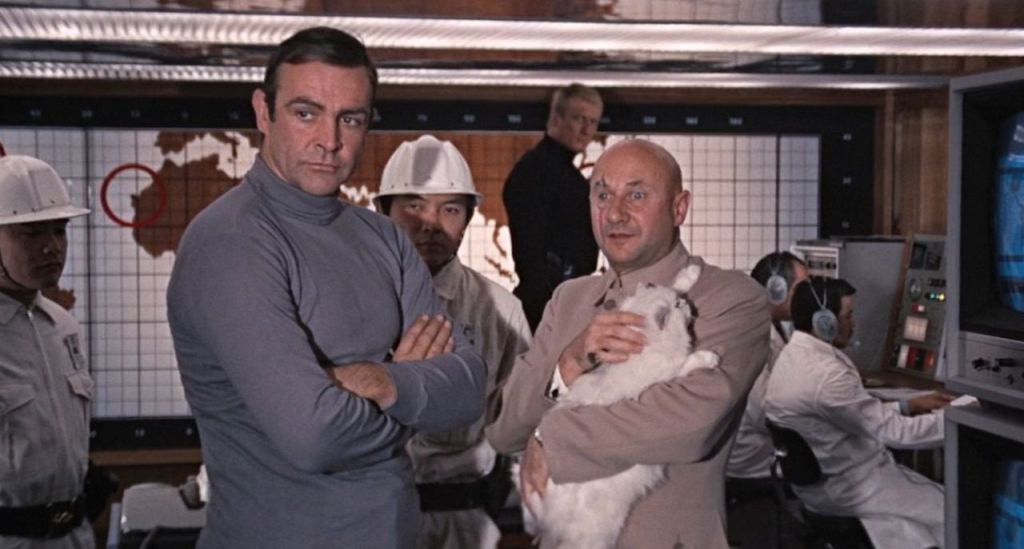
5. You Only Live Twice (1967)
When folks who haven’t actually gone back to watch the old Bond movies think of what Connery’s era looked like, You Only Live Twice is probably what they’re imagining: a bald, scarred supervillain with a Persian cat on his lap; a hollowed out volcano in which evil designs for world domination are hatched; a climax where the hero leads a team of ninjas in an assault against baddies with World War III on the line.
You Only Live Twice is ‘60s Bondmania at its cheesiest. It is also where director Lewis Gilbert set the table for 007 at his most epic, with future adventures about megalomaniacs in ludicrous secret lairs (with ludicrously amazing productions designs, courtesy of Ken Adam) all growing out of this wellspring. With that said, we wish YOLT had aged better than it now plays. But with its story of Bond “dying” his skin and getting a bowl haircut to look Japanese (he doesn’t) and its exoticized depiction of the “Far East,” particularly Japanese women who are stereotyped as subservient and eager to please a European man, the film is fairly uncomfortable to the modern gaze.
Worse still as a Bond movie, it’s also fairly dull until the ninja-climax, in no small part because this is the one where Connery began to look checked out. It’s no secret his relationship with Bond producers Cubby Broccoli and Harry Saltzman was tumultuous, and after years of overexposure to screaming fans, Connery was looking for the exit. He’d retire (briefly) from the role following this film, but he already looks done onscreen. At least he gets to feed one of Blofeld’s henchmen to a pond of ravenous piranhas. “Bon appetit.”
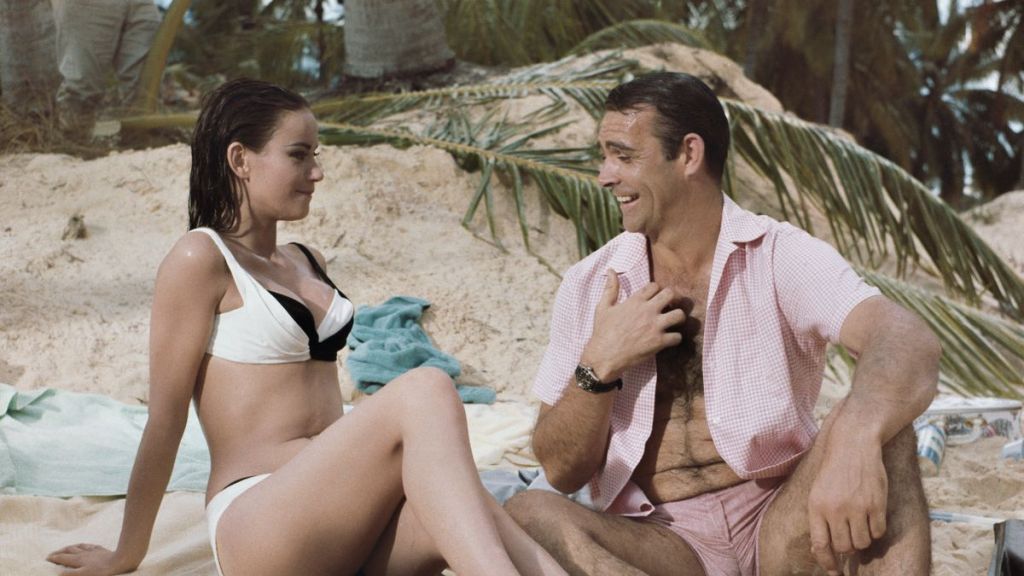
4. Thunderball (1965)
After helping Connery establish the suave, yet rugged, persona of the cinematic James Bond—which should not be mistaken for Fleming’s own literary creation—director Terrence Young returned to the Bond franchise with Thunderball. However, in the interim between Young/Connery’s first two Bond movies and this one, the game had changed thanks to Guy Hamilton’s goofier Goldfinger (1964). As a result Thunderball, feels a bit awkward as it tries to tap into the larger-than-life, cartoonish aspects of Goldfinger while retaining Young’s general sensibility of cool (and bordering on cold-hearted) espionage.
Even so, Thunderball was the height of Bondmania. The character was arguably never bigger than this, with the movie defining the pop culture mood instead of responding to it. Connery is also in top-form as 007 at his most cynical. The pleasure on his face as he steals the villain’s girl out from under him, and in plain sight, is almost sinister. And after using the evil Luciana Paluzzi as a human shield for a silencer’s bullet at a Bahamian nightclub, Connery’s delivery of “Mind if my friend sits this one out, she’s just dead,” is so ruthless you don’t know whether to laugh or shudder.
The chauvinistic gender politics of Thunderball are incredibly problematic, and have fairly become the center of most discourses about the character’s more neolithic aspects, but the movie is one of the few in Connery’s day where the main “Bond Girl” (Claudine Auger) goes in with eyes wide open as to what kind of relationship Bond is looking for (read: none), and to date she is the only leading lady who’s saved Bond in the climax by killing the villain, her abusive lover Largo (Adolfo Celi). To this day, even the more progressive Craig era seemed to always reverse that.
When coupled with a genuinely wicked performance by Paluzzi as Volpe and a few all-time great Bond sequences, including an opening scene where Connery uses a jetpack (because OF COURSE!), it’s hard not to find something of quality in Thunderball. It’s just a shame, then, that those underwater fight scenes at the end are so dire.

3. Dr. No (1962)
Here is the James Bond movie that started it all. While the book it is based on wasn’t Fleming’s first or even third Bond novel, the film’s refusal to even consider how James wound up a 00 agent likely worked to its advantage in ’62. Connery materializes as if out of smoke, fully formed and unmistakably the coolest man in the room… and maybe in all of cinema. The cigarette drips from his lip as he utters, “Bond, James Bond,” at a baccarat table. Audiences didn’t stand a chance.
Revisiting Dr. No now is also an interesting exercise in watching an actor, director, and whole team of filmmakers attempt to build a myth. The pieces are mostly there, but they’re not yet in the right order. There is no real opening song, a total absence of gadgets, and Connery’s Bond is Savile Row personified, but if you cut through those bespoke suits he still bleeds. He is not yet a superhero; he’s a man on a job.
That also is to the movie’s advantage in other ways, such as how matter of factly cruel Connery is when 007 shoots an unarmed man in what is essentially an execution. The way Connery plays it, you get the sense James is more concerned with balancing his cigarette than the life he’s taking. Conversely though, Connery turns on maximum wolfish charm as he hums a little calypso to Ursula Andress as Honey Ryder, the first “Bond Girl” whose emergence from the Jamaican sea emulates Botticelli’s Venus. (One could also note Honey has as much dimensionality in the script as a wall painting).
It’s mythic, yet strangely more intimate than the Bond iconography we’d come to later know.
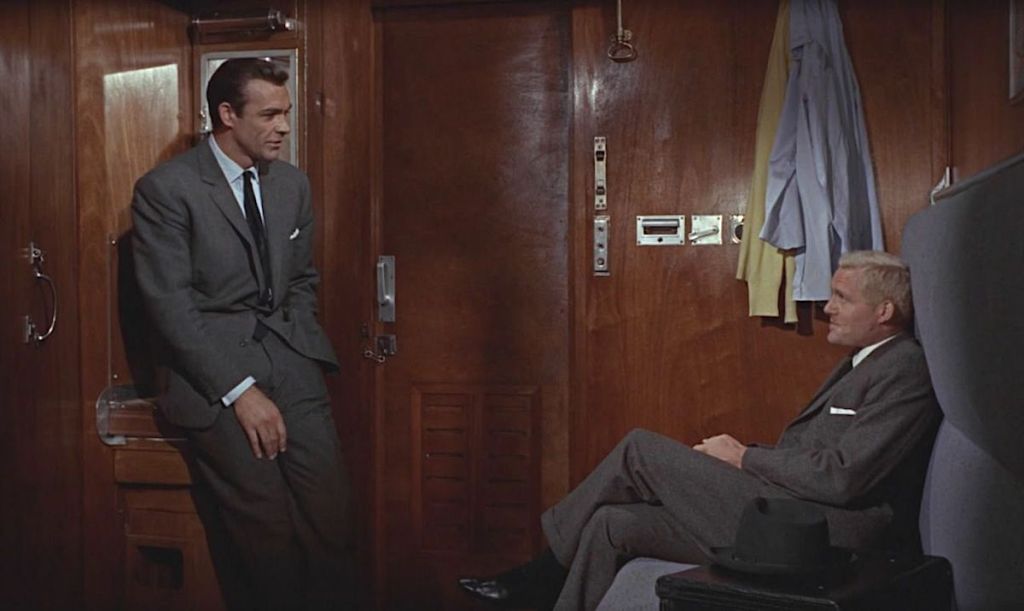
2. From Russia With Love (1963)
We are aware a case can be made for From Russia With Love being the finest Bond movie ever produced. No less than Connery has made that argument, with the actor citing his second outing as his favorite on multiple occasions. And for those looking for a ripping espionage flick, From Russia With Love is hard to beat. Save for a few sequences alluding to the vile secret society of SPECTRE (in the book, it was the Soviet espionage agency SMERSH Bond was up against) and a campy fantasy sequence involving two dark-haired Romani women vying for James’ approval, FRWL could be viewed as a straight-ahead Cold War thriller.
The movie revolves around Bond and MI6 being so desperate to retrieve a Soviet code machine, the Lektor, that 007 is sent into an obvious honeypot trap in which a Soviet clerk (Daniela Bianchi) claims to have fallen in love with the British intelligence officer’s photograph and now wants to defect. What neither Bond or Bianchi’s Tatiana realizes is this trap was set by SPECTRE and some of the best villains in movie history: Lotte Lenya’s delightfully repellent Rosa Klebb and Robert Shaw’s brutal Red Grant.
The cat-and-mouse game between west and east, Bond and Grant, is the centerpiece of a slow-boiling film that reaches scalding levels of heat by the time the two are fighting to the death on the Orient Express in what remains the most visceral fisticuffs in the series. There is no music, no special effects, just ruthless murder. That no-nonsense quality makes this the best to some, but personally, we lean toward James being a little more aware of his surroundings… and having a little more fun than the time he found himself on his knees bartering for a smoke and his life.
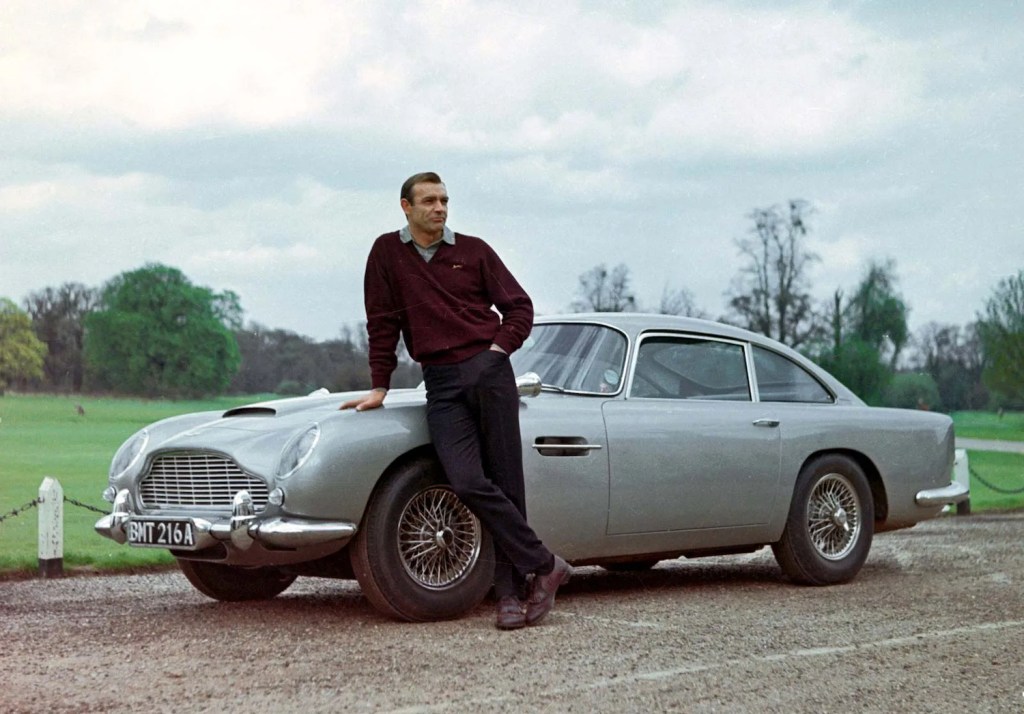
1. Goldfinger (1964)
If Connery’s performance came close to fully formed in Dr. No, Goldfinger is where the rest of the pieces fell into place and the Bond franchise as we still know it was born. Director Guy Hamilton steps into the helmer’s chair for the first time and brings a more mischievous sensibility to the proceedings. Perhaps “camp” would even be accurate. But when the camp is as good as Connery barely masking his astonishment at the words “ejector’s seat” in Q-branch, who cares? Watching Bond turn the Aston Martin into a svelte tank is half the fun.
The rest of it is Connery irrepressibly boyish charm as he has the absolute time of his life in almost any situation: cheating the notorious cheater Auric Goldfinger (Gert Fröbe) on the golf course; treating his imprisonment on Goldfinger’s Kentuckian estate as an extended holiday; and even facing down a laser beam headed directly toward his crotch. The latter admittedly leaves him nonplussed, briefly, but after he talks his way out of that dicey situation, he’s quick to come back with a joke.
Goldfinger also features one of the most intriguing evil schemes in the series, with Auric planning to irradiate America’s gold supply at Fort Knox, as well as one of the best leading women the franchise introduced in the ‘60s. Honor Blackman’s Pussy Galore is so well-drawn by the actress (making her the first “Bond Girl” to seem to have an actual personality and interior life) that she even gets past that unfortunate name from Fleming.
The pieces of Goldfinger simply come together like James’ finely tailored gray suit—it cuts the perfect shape for this guy. Fifty-eight years later, it’s still the best.
